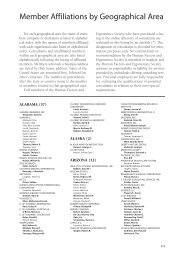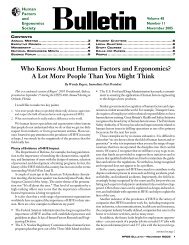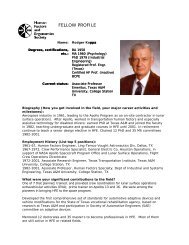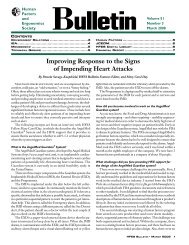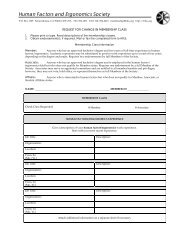Next Generation Air Transportation System Integrated Plan
Next Generation Air Transportation System Integrated Plan
Next Generation Air Transportation System Integrated Plan
Create successful ePaper yourself
Turn your PDF publications into a flip-book with our unique Google optimized e-Paper software.
• Improve aviation safety record by ensuring users are constantly<br />
informed of changes in system conditions so they can take safer,<br />
better informed actions<br />
• Develop complementary policies between and among<br />
government stakeholders:<br />
- Develop a shared situational awareness requirements process<br />
• Support containment of government costs by:<br />
- Eliminating development and maintenance of duplicative<br />
and conflicting data<br />
- Reducing workload in some operational areas<br />
- Reducing unnecessary security actions<br />
• Provide for common defense and air security by distributing<br />
relevant intelligence and system status information in a timely<br />
manner<br />
• Define shared situational awareness security approach and<br />
architecture for 2025:<br />
- Baseline current systems<br />
- Define incremental growth<br />
Cross-strategy Linkage<br />
This IPT will coordinate its work with the following IPTs to fulfill<br />
its mission:<br />
• Harmonize Equipage and Operations Globally<br />
• Establish an Effective Security <strong>System</strong> without Limiting<br />
mobility or Civil Liberties<br />
• Establish an Agile <strong>Air</strong> Traffic <strong>System</strong><br />
• Establish a Comprehensive Proactive Safety Management<br />
Approach<br />
• Develop <strong>System</strong>-wide Capability To Reduce Weather Impacts<br />
7.5 Establish a Comprehensive Proactive<br />
Safety Management Approach<br />
Develop and implement a common and comprehensive risk<br />
management doctrine at the national level that is applied<br />
to aviation and space travel. Encourage and participate in<br />
global safety practices to ensure the safety of the traveling<br />
public and cargo. Develop and implement a cutting-edge<br />
operational data analysis capability that identifies safety issues.<br />
Promote expansion of the U.S. capability to meet national and<br />
international safety goals and objectives.<br />
Tie into Objectives<br />
• Maintain aviation record as the safest mode of transportation<br />
• Improve the level of safety of the U.S. air transportation system<br />
while accommodating future growth and changes in system<br />
operations<br />
IPT Mission<br />
• Create a national-level integrated safety management<br />
framework that addresses all facets of the air transportation<br />
system, building safety design assurances into operations<br />
and products<br />
• Establish an on-going, integrated operational data analysis<br />
capability to proactively identify and resolve safety concerns<br />
before incidents occur<br />
• Establish and track a safety improvement culture where safety<br />
and its continuous improvement are seen as the primary<br />
goals<br />
• Lead and manage research efforts to determine national<br />
safety strategy<br />
Transformation Direction<br />
• Develop a comprehensive approach to safety across the<br />
system-of-systems at the national level<br />
• Develop a comprehensive set of safety management principles<br />
and practices to establish a common framework for the<br />
aviation community:<br />
- Create an integrated safety doctrine and program standards,<br />
and define national comprehensive safety management<br />
doctrine and terms of reference<br />
- Develop the means to forecast and manage safety risks;<br />
apply advanced safety/risk analysis methodologies,<br />
including those from other industries, to design new<br />
operations and systems to target levels of safety; identify<br />
and model accident precursors; identify and model incident<br />
investigations as they apply to the safety management<br />
system — how incident investigations are used to identify<br />
hazards<br />
• Ensure an evolution of present certification, testing, and<br />
inspection of individual system elements to comprehensive<br />
approvals of operators’ and manufacturers’ safety management<br />
programs:<br />
- Compliance with regulations is still the basis for future<br />
system safety management<br />
- Promote the evolution to a comprehensive system<br />
Joint <strong>Plan</strong>ning & Development Office 29









